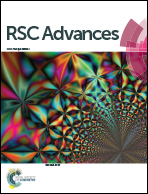The effect of peripheral substituents attached to phthalocyanines on the third order nonlinear optical properties of graphene oxide–zinc(ii)phthalocyanine hybrids
Abstract
Two kinds of graphene oxide–zinc phthalocyanine (GO–ZnPc) hybrid materials have been prepared by the covalent functionalization method. The morphologies and structures of the two kinds of GO–ZnPc hybrids are characterized by a series of methods, such as scanning electron microscopy, atomic force microscopy, X-ray photoelectron spectroscopy, Fourier transform infrared, ultraviolet-visible absorption and fluorescence spectroscopies. From the fluorescence spectra, the two kinds of GO–ZnPc hybrids display strong fluorescence quenching by the photo-induced electron transfer (PET) process from ZnPc moieties to the GO. Energy diagrams show that a PET process from ZnPc molecules to GO nanosheets exists. The third order nonlinear optical (NLO) properties of GO–ZnPc hybrids are investigated by the Z-scan technique at 532 nm with 4 ns laser pulses. The nonlinear absorption coefficient β value of GO–ZnPc(DG)4 is larger than that of GO–ZnPc(TD)4 because GO–ZnPc(DG)4 possesses peripheral substituents with a stronger electron-donating effect compared to GO–ZnPc(TD)4.


 Please wait while we load your content...
Please wait while we load your content...